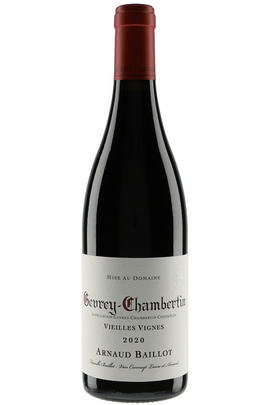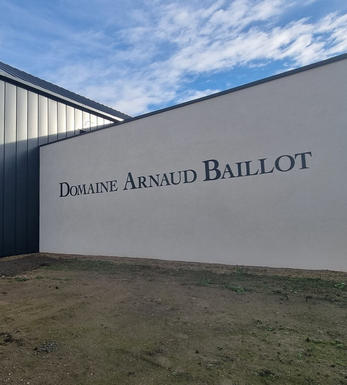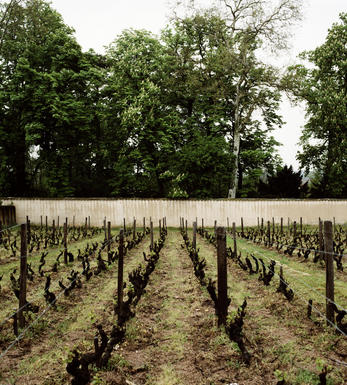
2021 Gevrey-Chambertin, Combe aux Moines, 1er Cru, Arnaud Baillot, Burgundy

About this WINE

Arnaud Baillot
Domaine Arnaud Baillot is situated in the heart of the Côte d’Or, specifically in Beaune, a renowned wine-producing region in Burgundy. Arnaud Baillot and his wife Laure, the granddaughter of Domaine Hudelot-Noëllat in Chambolle-Musigny, share a deep passion for the diverse wines the Burgundy region offers.
Their collaboration has led to the creation of a remarkable range of village and premier cru Burgundy wines. Arnaud Baillot plays a hands-on role in every aspect of winemaking, from meticulously selecting the grape sources to overseeing the winemaking process and carefully choosing the type of barrels and ageing durations for each wine.
In 2017, the couple took a significant step by acquiring a small vineyard in the Côte de Beaune, marking the beginning of their venture into producing estate wines under the label Domaine Arnaud Baillot. Their winemaking philosophy revolves around respecting and showcasing the intricate terroirs of the Burgundy wine region, resulting in terroir-driven wines that truly exemplify the Burgundian character.
As they present their next vintage, it’s clear that Domaine Arnaud Baillot is committed to crafting limited-edition small-batch Burgundy crus, continuing to share their passion for and commitment to the complexity and uniqueness of the Burgundy wine region.

Gevrey-Chambertin
Gevrey-Chambertin is the largest wine-producing village in Burgundy’s Côte d'Or, with its vineyards spilling over into the next door commune of Brochon.
Located in the far north of the Côtes de Nuits above Morey-St Denis, classic Gevrey-Chambertin is typically deeper in colour, firmer in body and more tannic in structure than most red Burgundy. The best can develop into the richest, most complete and long-lived Pinot Noir in the world. This is largely thanks to the iron-rich clay soils, though much depends on whether the vineyard is located on either the steeper slopes (Evocelles, Clos St Jacques) or the flatter, richer soils (Clos Prieur, Combottes).
Whereas in the past there have been numerous underperformers in Gevrey-Chambertin exploiting the reputation of this famous village and its iconic Grands Crus, today there are many fine sources to choose from, and overall quality is higher than ever.
Gevrey-Chambertin’s greatest Grand Cru is named after the field of the monk Bertin (Champ de Bertin). In 1847, Gevrey appended the name of this illustrious vineyard, Chambertin, setting a trend for the other principle villages to follow. Le Chambertin may not be quite as sumptuous as Musigny or Richebourg, or as divinely elegant as La Tâche or Romanée-St Vivant, but it is matched only by the legendary Romanée-Conti for completeness and luscious intensity.
In all, Gevrey boasts an impressive nine Grands Crus, with the name of Chambertin retaining a regal omnipresence throughout its finest vineyard names. The other truly great Grand Cru is Chambertin-Clos de Bèze which has the right to sell its wines simply as ‘Chambertin’, and is the only wine allowed to put the Chambertin name before, rather than after, its own. Situated slightly further up the hill, the wines are fractionally less powerful yet full of sensual charm and finesse.
Quality-wise the next best are generally acknowledged to be Mazis-Chambertin and Latricières-Chambertin. The former is incredibly concentrated and very fine, but its structure is a little less firm than Le Chambertin. Latricières is less about power (although it can be explosively fruity) and more about an entrancing silkiness.
Situated slightly higher up the slope, Ruchottes-Chambertin is impressively rich, stylish and slightly angular. The tiny Griottes-Chambertin, which owes its name to the grill-pan shape of the vineyard rather than the wine’s griotte cherry aroma, is lower down the slope and boasts a velvety texture and rich fruit reminiscent of Chambertin itself. It is generally better than the lighter, although wonderfully fragrant Chapelle-Chambertin and Gevrey’s largest Grand Cru, the pure and seductive (if variable) Charmes-Chambertin.
Gevrey also has some outstanding Premier Crus on the south-east-facing slopes above the town. Les Cazetiers and especially Clos St Jacques produce some exceptional wines. Indeed Armand Rousseau, who pioneered domaine bottling here in the 1930s and is still one of the region’s very best producers, often sells his Clos St Jacques for more than several of his Grand Crus.
Drinking dates for these wines vary, but Grand Crus are generally best from at least 10 to 25 years, Premier Crus from eight to 20 years, and village wines from five to 12 years.
- 315 hectares of village Gevrey Chambertin
- 84 hectares of Premier Cru vineyards (20 in all). The foremost vineyards include Clos St Jacques, Lavaux St Jacques, Combottes, Corbeaux, Cherbaudes, Cazetiers.
- 55 hectares of Grand Cru vineyards: Chambertin, Chambertin Clos de Bèze, Latricières-Chambertin, Ruchottes-Chambertin, Mazis-Chambertin, Charmes-Chambertin, Mazoyères-Chambertin, Chapelle-Chambertin, Griottes-Chambertin..
- Recommended producers: Bachelet, Dugat, Esmonin, Mortet, Rossignol Trapet, Rousseau, Serafin, Bernstein
- Recommended restaurants : Chez Guy (good wine list), Rôtisserie du Chambertin (and Bistro)

Pinot Noir
Pinot Noir is probably the most frustrating, and at times infuriating, wine grape in the world. However when it is successful, it can produce some of the most sublime wines known to man. This thin-skinned grape which grows in small, tight bunches performs well on well-drained, deepish limestone based subsoils as are found on Burgundy's Côte d'Or.
Pinot Noir is more susceptible than other varieties to over cropping - concentration and varietal character disappear rapidly if yields are excessive and yields as little as 25hl/ha are the norm for some climats of the Côte d`Or.
Because of the thinness of the skins, Pinot Noir wines are lighter in colour, body and tannins. However the best wines have grip, complexity and an intensity of fruit seldom found in wine from other grapes. Young Pinot Noir can smell almost sweet, redolent with freshly crushed raspberries, cherries and redcurrants. When mature, the best wines develop a sensuous, silky mouth feel with the fruit flavours deepening and gamey "sous-bois" nuances emerging.
The best examples are still found in Burgundy, although Pinot Noir`s key role in Champagne should not be forgotten. It is grown throughout the world with notable success in the Carneros and Russian River Valley districts of California, and the Martinborough and Central Otago regions of New Zealand.


Buying options
Add to wishlist
Description
This is a wine light in colour but not light in perfume or weight. On the nose, ripe and juicy plums still with a crunch meet sweet soy sauce and crushed violets. There is a spicy note on the palate that is complimented by well rounded tannins which leave a lovely chalky finish.
Drink 2024 - 2038
Amy Johnson, Account Manager, Berry Bros. & Rudd
wine at a glance
Delivery and quality guarantee